

 Rainforests are bursting with life. Not only do millions of species of plants and animals live in rainforests, but people also
call the rainforest their home. In fact, indigenous, or native, or Indian peoples have lived in tropical forests for thousands of years.
Through years of natural selection, forest people have evolved to be smaller than people who do not live in the rainforest. They also sweat less
because the forest's high humidity means that sweat cannot evaporate, making sweating a poor way to cool off. Forest people also drink less water because
their food contains a lot of water.
Rainforests are bursting with life. Not only do millions of species of plants and animals live in rainforests, but people also
call the rainforest their home. In fact, indigenous, or native, or Indian peoples have lived in tropical forests for thousands of years.
Through years of natural selection, forest people have evolved to be smaller than people who do not live in the rainforest. They also sweat less
because the forest's high humidity means that sweat cannot evaporate, making sweating a poor way to cool off. Forest people also drink less water because
their food contains a lot of water.
Indigenous people live in small groups or tribes. They are either hunter-gatherers (who get their food by hunting for meat and fishing for fish and gathering edible plants, like starchy roots and fruit) or hunter-gardeners (who have small gardens in cleared areas of the forest). They build their homes from trees and palm leaves. They have their own spiritual beliefs. Rubber tappers also live in the rainforests of Brazil. They are not Indians but have learned to take rubber from rubber trees without killing the trees.
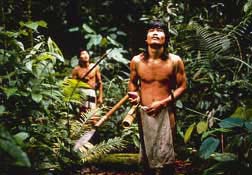 Most tribal children don't go to schools like ours. Instead, they learn about
the forest from their parents and other people in their community.
They are taught how to survive in the forest. They learn how to hunt and fish, and which plants are useful as medicines or food. Some of these
children know more about rainforests than scientists who have studied rainforests for many years!
Most tribal children don't go to schools like ours. Instead, they learn about
the forest from their parents and other people in their community.
They are taught how to survive in the forest. They learn how to hunt and fish, and which plants are useful as medicines or food. Some of these
children know more about rainforests than scientists who have studied rainforests for many years!
Over many generations tribal people have discovered many of the forests' secrets. They have accumulated a great wealth of knowledge about the forest and have learned how to live in the forest without damaging it. They know how to use thousands of edible, medicinal and poisonous plants and how to grow crops in the forest's poor soil. They also know how to hunt and fish without driving the animals to extinction. Unfortunately many of these cultures are being wiped out as they come into contact with modern man.
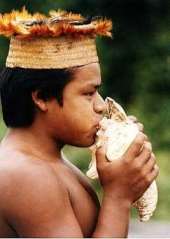 Besides hunting, gathering wild fruits and nuts and fishing, indigenous people also plant small gardens for other sources of food, using a sustainable
farming method called shifting cultivation. First they first clear a small area of land and burn it. Then they plant many types of plants, to be used
for food and medicines. After a few years, the soil has become too poor to allow for more crops to grow and weeds start to take over. They then move
to a nearby uncleared area. This land is traditionally allowed to regrow for 10-50 years before it is farmed again. Shifting cultivation is still
practiced by those indigenous groups who have access to a large amount of land. However, with the growing number of non-indigenous farmers and the
shrinking rainforest, especially in Indonesia and Africa, are now forced to remain in one area. The land becomes a wasteland after a few years of
overuse, and cannot be used for future agriculture.
Besides hunting, gathering wild fruits and nuts and fishing, indigenous people also plant small gardens for other sources of food, using a sustainable
farming method called shifting cultivation. First they first clear a small area of land and burn it. Then they plant many types of plants, to be used
for food and medicines. After a few years, the soil has become too poor to allow for more crops to grow and weeds start to take over. They then move
to a nearby uncleared area. This land is traditionally allowed to regrow for 10-50 years before it is farmed again. Shifting cultivation is still
practiced by those indigenous groups who have access to a large amount of land. However, with the growing number of non-indigenous farmers and the
shrinking rainforest, especially in Indonesia and Africa, are now forced to remain in one area. The land becomes a wasteland after a few years of
overuse, and cannot be used for future agriculture.
Early accounts of these people by European explorers indicate a far denser population lived in the forest than today. Many of these original peoples, such as the Caribs (after whom the Caribbean Sea is named) have disappeared completely. Others are only scattered remnants of what they once were. However thousands of distinct ethnic groups with their own distinctive language and culture remain today in tropical rainforests around the world.
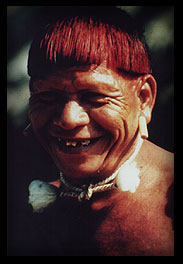 Indigenous people revere the forest that, until the present, has protected them from
outsiders and given them everything they need. They live what is called a sustainable existence, meaning they use the land without doing harm to the
plants and animals that also call the rainforest their home. As a wise indigenous man once said, "The earth is our historian, our educator, the
provider of food, medicine, clothing and protection. She is the mother of our races."
Indigenous people revere the forest that, until the present, has protected them from
outsiders and given them everything they need. They live what is called a sustainable existence, meaning they use the land without doing harm to the
plants and animals that also call the rainforest their home. As a wise indigenous man once said, "The earth is our historian, our educator, the
provider of food, medicine, clothing and protection. She is the mother of our races."
Indigenous peoples have been losing their lives and the land they live on ever since Europeans began colonizing their territories 500 years ago. Unknowingly, the first European explorers to what is now called Latin America brought diseases such as small-pox, measles and even the common cold to which Europeans had developed varying degrees of immunity but to which indigenous peoples had no immunity at all since none of them had never been exposed to these diseases before.
As a result of those encounters, over ninety percent of the native peoples died from diseases that today we regard as minor and even then were fatal to only a small fraction of Europeans. This disaster was repeated again when Europeans explored Oceania. Since then many indigenous groups have also been killed and driven off by settlers wanting their land, or enslaved to work in sugar plantations or mines. However, until about forty years ago, the lack of roads prevented most outsiders from exploiting the rainforest and entering indigenous territories. These roads, constructed for timber and oil companies, cattle ranchers and miners, have opened up vast areas for outsiders to grab and exploit and have made possible the destruction of millions of acres of rainforest each year.
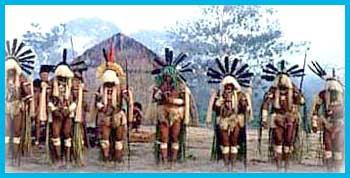 There are perhaps a thousand or more forest groups around the world with many close to extinction! In 1900, Brazil had 1,000,000 (one million) Indians.
Today, there are less than 200,000. Eighty-seven tribes have been killed off in Brazil since 1900 - that's almost one tribe per year!
There are perhaps a thousand or more forest groups around the world with many close to extinction! In 1900, Brazil had 1,000,000 (one million) Indians.
Today, there are less than 200,000. Eighty-seven tribes have been killed off in Brazil since 1900 - that's almost one tribe per year!
Although indigenous people have lived on their lands for thousands of years, they do not own it, because they have not filed "deeds" of land and do not possess "title." Therefore governments and other outsiders do not recognize their rights to the land. They have no other choice but to move to different areas, sometimes even to the crowded cities. They often live in poverty because they have no skills useful for a city lifestyle and little knowledge about the urban culture. For example, they know more about gathering food from the forest than buying food from a store!
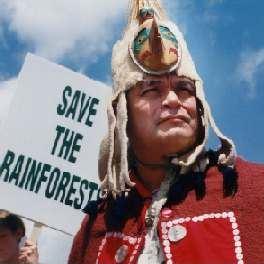 Indigenous groups are beginning to fight for their land, most often through peaceful
demonstrations. Such actions may cause them to be arrested or even to lose their lives, but they know that if they take no action, their land and culture
could be lost forever.
Indigenous groups are beginning to fight for their land, most often through peaceful
demonstrations. Such actions may cause them to be arrested or even to lose their lives, but they know that if they take no action, their land and culture
could be lost forever.
Many people living outside of rainforests want to help protect the indigenous people's culture. They understand that indigenous people have much to teach us about rainforests. By working with these groups, we can learn important information about rainforests - its ecology, medicinal plants, food and other products. It is crucial to realize that they have a right to practice their own lifestyle, and live upon the land where their ancestors have lived before them.
Indigenous peoples have a right to live and because we should celebrate their difference from us since diversity enriches life and culture. We should be ashamed that the 20th century has witnessed more genocides of peoples and more extinctions of animals than any other in history.In addition, indigenous peoples possess an enormous body of almost irreplaceable information and skills about living in the rainforest without destroying it.
Within the next few decades, the fate of the world's remaining indigenous peoples, the fragile environments they occupy, and the valuable knowledge that they embody could well be decided once and for all. A number of individuals, corporations, and states are already pursuing their own "final solutions." The 20th century will be remembered either as the century when we destroyed much of the Earth's genetic and cultural diversity, or the century when peoples learned to live together and share their knowledge in order to maintain the diversity upon which we all depend. Working together, we can make a world of difference.
Tribes of indigenous people
We often overlook the millions of people that live in the rain forests. Did you know that there are about 50,000,000 tribal people living in world's rainforests? Local materials are used to make their blow guns, spears, and arrows. The forest also provides building and roofing materials, wild cotton for clothing, pharmaceuticals, cosmetics, and more. In fact, just about every need can be met by the rain forest. For these people, the rain forest is like living in a gigantic mall. As we cut more and more trees and destroy more and more of the forests, we are also killing people. Many native tribes have been exterminated already because their governments failed to protect them from logging companies, the mining companies and the slash and burn farmers. Here is some more information about the larger and more well-known tribes:
 The Pygmies:
The 125cm tall, nomadic Efe pygmies living in Central Africa have no gardening activity. The men sometimes hunt elephant and buffalo. More often they hunt
monkeys, birds and rodents and collect fruit, honey, birds eggs and insects. They rely almost exclusively on the help of a bird called the Greater
Honeyguide to direct them to the beehives. This little bird leads the Pygmies with its rasping, churring chatter and its white outer tail feathers to
point out the proper tree. The bird lives on beeswax, so after the Pygmies climb the tree with a bundle of smoking leaves to put the bees to sleep, they
take the honey and leave the beeswax behind as a reward for the bird. The women gather nuts, roots and mushrooms. They have few possessions:
baskets, bow and arrows, bark clothing, and some simple musical instruments. (Right picture) The Pygmy woman is preparing food outside her hut, with her
baby cradled on her back.
The Pygmies:
The 125cm tall, nomadic Efe pygmies living in Central Africa have no gardening activity. The men sometimes hunt elephant and buffalo. More often they hunt
monkeys, birds and rodents and collect fruit, honey, birds eggs and insects. They rely almost exclusively on the help of a bird called the Greater
Honeyguide to direct them to the beehives. This little bird leads the Pygmies with its rasping, churring chatter and its white outer tail feathers to
point out the proper tree. The bird lives on beeswax, so after the Pygmies climb the tree with a bundle of smoking leaves to put the bees to sleep, they
take the honey and leave the beeswax behind as a reward for the bird. The women gather nuts, roots and mushrooms. They have few possessions:
baskets, bow and arrows, bark clothing, and some simple musical instruments. (Right picture) The Pygmy woman is preparing food outside her hut, with her
baby cradled on her back.
 (Left picture) Pygmy gathering honey
(Left picture) Pygmy gathering honey
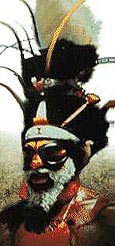
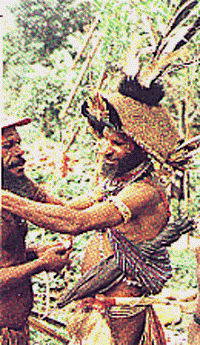 The Huli:
The Huli are one of the many tribes that live in the remote highland forests of Papua New Guniea.
They live by hunting, gathering plants and growing
crops. Men and women live seperately, in large group houses. The men of this tribe wear large wigs of matted human hair, that they grow themselves. They
must stay in a special, enclosed "school" in the forest for up to three years while their hair grows. This school is a group of huts in the
rain forest surrounded by tall wooden fences. Every day the men sprinkle special water on their hair and use twigs and rope to shape the wig. Once it has
grown bushy enough, they shave their heads using twine and rope. Then they use natural dyes found in the rain forest to color their wigs red or black.
They decorate them with flowers, leaves, shells, bones, feathers, and fur that they also collect from the rain forest. Many of them have two wigs, one for
wearing everyday and one for ceremonies. When they dress up, they paint their
The Huli:
The Huli are one of the many tribes that live in the remote highland forests of Papua New Guniea.
They live by hunting, gathering plants and growing
crops. Men and women live seperately, in large group houses. The men of this tribe wear large wigs of matted human hair, that they grow themselves. They
must stay in a special, enclosed "school" in the forest for up to three years while their hair grows. This school is a group of huts in the
rain forest surrounded by tall wooden fences. Every day the men sprinkle special water on their hair and use twigs and rope to shape the wig. Once it has
grown bushy enough, they shave their heads using twine and rope. Then they use natural dyes found in the rain forest to color their wigs red or black.
They decorate them with flowers, leaves, shells, bones, feathers, and fur that they also collect from the rain forest. Many of them have two wigs, one for
wearing everyday and one for ceremonies. When they dress up, they paint their
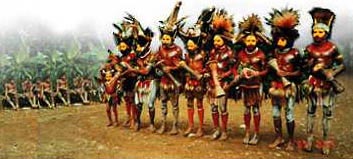 faces with juice from berries and rub pig fat over their bodies. Then they
put big bushy leaves in woven belts like a Hawaiian hula skirt and dance in a big circle. They'll usually invite other tribes from the area to join them.
The wigmen can be very fierce, so these dances are a good way to build friendships with other
tribes. (Left picture)Huli Wigmen ceremony
faces with juice from berries and rub pig fat over their bodies. Then they
put big bushy leaves in woven belts like a Hawaiian hula skirt and dance in a big circle. They'll usually invite other tribes from the area to join them.
The wigmen can be very fierce, so these dances are a good way to build friendships with other
tribes. (Left picture)Huli Wigmen ceremony
¡@
¡@

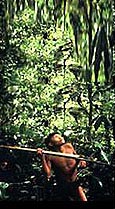 The Yanomamo:Amazonian deep-forest Yanomamo are a group of forest people that
can literally run up heavy trunked emergent trees (over 200 feet) without breaking a sweat. It's because of their remarkably wide feet, which also
have advantages running around the muddy rain forest floors.Their village life is centered around the yano, or communal house.
The yano is a large, circular building constructed of vine and leaf thatch, which has a living space in the middle.
(Right picture) Yanomami men eating a meal. (Left picture) Hunting Yanomamo
The Yanomamo:Amazonian deep-forest Yanomamo are a group of forest people that
can literally run up heavy trunked emergent trees (over 200 feet) without breaking a sweat. It's because of their remarkably wide feet, which also
have advantages running around the muddy rain forest floors.Their village life is centered around the yano, or communal house.
The yano is a large, circular building constructed of vine and leaf thatch, which has a living space in the middle.
(Right picture) Yanomami men eating a meal. (Left picture) Hunting Yanomamo
The Kayapo: In Brazil about 2,500 Kayapo natives live in an area about the size of Wales. They garden, hunt, fish and gather wild foods. They use over 600 species of plants for food, medicine, dyes, oils, soaps, fibres and insect repellent. Numbering about 20,000, they are largest group of Indians that live in Brazil.
The Gimi: About 10,000 of them live in the highlands of Papua New Guinea. The men hunt small mammals and birds, and the women tend gardens of sweet potatoes and other similar crops. Further west live the Penan of Borneo who are perhaps the most ancient of the forest dwellers and have lived there for nearly 40,000 years!